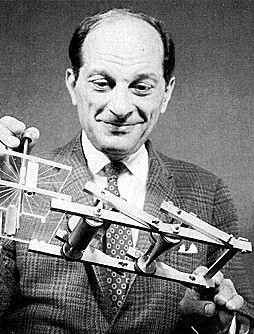-
(b.) -1909 April 13(d.)1984 May 13
Bio/Description
A renowned mathematician of Polish-Jewish origin, he participated in America's Manhattan Project, originated the Teller?Ulam design of thermonuclear weapons, suggested the Monte Carlo method of computation, proposed the idea of nuclear pulse propulsion and developed a number of mathematical methods in number theory, set theory, ergodic theory and algebraic topology. He was born in Lemberg, Galicia, in the (at that time) Austro-Hungarian Empire, but in 1918, it became part of the Second Polish Republic, and the city took on its traditional Polish name, Lw?w. In 1939, following the Molotov-Ribbentrop Pact, the Soviets invaded Poland, and the city was renamed Lviv, which is the Ukrainian form of its name, and by which it is known today. He was a member of a wealthy banking and timber-processing family who were part of the large Jewish minority population of Lw?w. From 1916 until 1918, his family lived temporarily in Vienna. After they returned, Lw?w became the epicenter of the Polish-Ukrainian War, during which the city experienced a Ukrainian siege and a Polish pogrom. In 1919, he entered Lw?w Gymnasium Nr. VII, from which he graduated in 1927. Shortly thereafter, he began studies at the Lw?w Polytechnic Institute. Here, under the supervision of Kazimierz Kuratowski, he received his M. A. degree in 1932 and his D.Sc. in 1933. From 1931 until 1939, he traveled to and studied in Vilnius, Vienna, Zurich, Paris, and Cambridge. He was a member of the Lw?w School of Mathematics. Mathematicians of this "school" met for long hours at the Scottish Caf?, where the problems they discussed were collected in the famous Scottish Book in which he is a major presence. Of the 193 problems recorded between 1935 and 1941, he contributed 40 problems as a single author, another 11 with Banach and Mazur, and an additional 15 with others. In 1957, he received from Steinhaus a copy of the book, which had survived the war, and translated it into English. In 1935, John von Neumann, whom he had met during his travels in Europe, invited him to come for a few months to the Institute for Advanced Study in Princeton, NJ. In December of that year, he sailed to America. In Princeton, he went to lectures and seminars, where he heard Oswald Veblen, James Alexander, and Albert Einstein. During a tea party at von Neumann's house, he became acquainted with G. D. Birkhoff, who suggested that he apply for a position with the Harvard Society of Fellows. From 1936 to 1939, after following up on Birkhoff's suggestion, he spent summers in Poland and academic years at Harvard University in Cambridge, MA. Here, he worked with John C. Oxtoby to establish important results regarding ergodic theory, which appeared in Annals of Mathematics in 1941. In 1940, he took a position as assistant professor at the University of Wisconsin in Madison, WI, and became an American citizen in 1941. In late spring of 1943, he wrote a letter of inquiry to von Neumann about a war job. In October, he received an invitation to join an unidentified project near Santa Fe, New Mexico. This letter was signed by Hans Bethe, who had been appointed as Director of the Theoretical Divison by J. Robert Oppenheimer, the scientific director of the Los Alamos laboratory. At this time, he knew nothing of Los Alamos. To learn more, he checked out of the library a New Mexico guidebook. On the checkout slip he found the names of his Wisconsin colleagues, Joan Hinton, David Frisch, Joseph McKibben, and others, who had mysteriously disappeared from Madison to secret war jobs. This was his introduction to the Manhattan Project. He was an early proponent of using computers to perform "mathematical experiments." His most notable contribution here may have been his part in the Fermi?Pasta?Ulam experiments, an early numerical study of a dynamical system. While at Los Alamos he also suggested the Monte Carlo method for evaluating complicated mathematical integrals that arise in the theory of nuclear chain reactions. This method searched for solutions to mathematical problems using a statistical sampling method with random numbers. It is now widely used in computer implementations of mathematical software. He was among the first to refer to the technological singularity?and possibly the originator of the metaphor itself?in May 1958, while referring to a conversation with John von Neumann: One conversation centered on the ever accelerating progress of technology and changes in the mode of human life, which gives the appearance of approaching some essential singularity in the history of the race beyond which human affairs, as we know them, could not continue. In 1965, he took a position at the University of Colorado. As he remained a consultant at Los Alamos, he divided his time between Boulder, Colorado, USA and Santa Fe, New Mexico, from which he commuted to Los Alamos. Later he and his wife spent winters in Gainesville, Florida, where he had a position with the University of Florida.
-
Date of Birth:
1909 April 13 -
Date of Death:
1984 May 13 -
Gender:
Male -
Noted For:
Originator of the metaphor, technological singularity, referring to the ever accelerating progress of technology and changes in the mode of human life, which gives the appearance of approaching some essential singularity in the history of the race beyond which human affairs, as we know them, could not continue -
Category of Achievement:
-
More Info:


